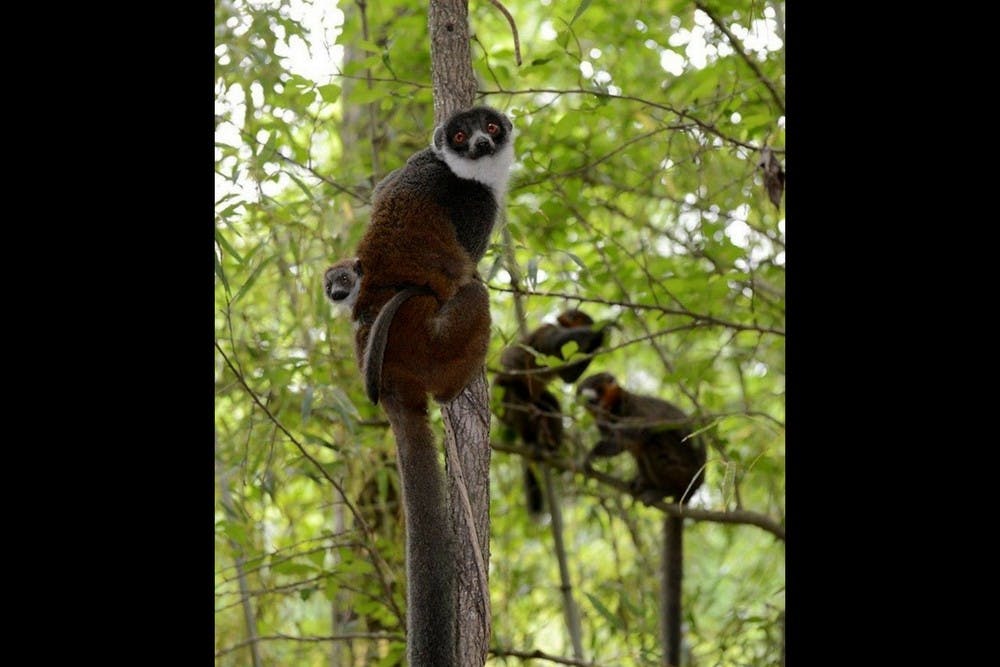Since March, the Duke Lemur Center has announced the birth of four lemur babies—two blue-eyed black lemurs, one mongoose lemur and one collared lemur.
The young lemurs were all born within a 14-day timespan. The two blue-eyed black lemurs are named McKinnon and Poehler; the mongoose lemur is called Nacho; and the collared lemur has been dubbed Bijou. This brings the center's total number of births this year to seven.
“Lemurs, in order to breed, are going to have to be healthy. They’re going to have to feel cared for and comfortable, and not be under stress,” said Sara Clark, director of the communications at the Lemur Center. “The fact that we [at the Lemur Center] are this good at breeding lemurs and caring for infants is a testament to the really high quality of research that is done here.”
Clark explained that while lemurs breed and give birth at different times and have varying gestation periods, they generally breed only once a year and are only receptive to breeding for 24-48 hours each year.
Megan McGrath, the education programs manager for the Lemur Center, explains that all infants are announced approximately one month after they are born to give them sufficient time to get strong, grow healthy and bond with their mother. Once they are old enough, they may be placed on the Lemur Center's tour path depending on their personality and their selected living space.
“Since we have about 230 lemurs here, not everybody is on the tour path because that would be a very long tour,” McGrath said. “Our curator does a really wonderful job of choosing which species and which animals might be a good representation on that path, and she absolutely takes into account the personalities of the animals involved.”
The number of births at the Lemur Center varies from year to year, mainly based on each species' "survival plan"—which is created by a group of experts worldwide, including the Association of Zoos and Aquariums, and is focused on boosting genetic diversity within the species' captive population. Clark stressed that breeding decisions are not made by the Lemur Center as an individual entity. Instead, it's a collaborative decision-making process.
So far this year, seven lemurs have been born at the Lemur Center, including one pygmy slow loris, two Coquerel's sifakas and the four most recent additions. Each of the baby lemurs has a unique name, such as “Gothicus," a Coquerel’s sifaka born in January, and “Warble"—a pygmy slow loris also born in January.
The two recent blue-eyed black lemur births are significant because there are only four blue-eyed black lemurs of breeding age in captivity in North America. Of those, three are housed at the Lemur Center. In Madagascar, blue-eyed black lemurs are threatened by habitat loss and forest fragmentation, and their small protected area is susceptible to wildfires.
“The blue-eyed black lemurs actually are thought to be diminished in the wild to maybe 1,000 individuals, and in 2015 it was estimated that that species would go extinct in the wild within 11 years,” Clark said. “What we are doing is creating a safety net within human care—safe in North America—to prevent the total extinction of that species.”
Mongoose lemurs are also critically endangered due to threats such as hunting and habitat loss in Madagascar. Collared lemurs are endangered due to the same threats—as well as the local pet trade, according to the Lemur Center’s website.
This is where the baby lemurs at the Lemur Center step in as ambassadors for their wild counterparts.
“Having really engaging, cute, young animals can really pull people in,” McGrath explained. “While they’re reeled in looking at the adorable baby lemur, we can continue to reel them in on the educational facts and the conservation issues facing them.”
Working in collaboration with lemur experts worldwide, the Lemur Center must plan and prepare to care for each lemur it breeds. Each animal brings with it a financial commitment of over $7,000 a year, and some of the lemurs can live as long as 33 years, Clark explained. Because of this, the breeding process is taken very seriously, and the Center will not commit if they believe they cannot support the animal.
Moving forward, the breeding experts at the Lemur Center will continue working in collaboration with experts from Parc Ivoloina in Tamatave, Madagascar to share their expertise in breeding, such as helping the experts from Parc form their own breeding programs. Clark noted. The Lemur Center has been training Parc employees since 1987—both at the Lemur Center and on-site in Madagascar.
“We always like to say that the Duke Lemur Center is helping lemurs not just in Durham, but also in Madagascar,” Clark said. “Our goal is not just to save or help this population of lemurs in North Carolina, we also want to help lemurs in their native forests.”
Get The Chronicle straight to your inbox
Sign up for our weekly newsletter. Cancel at any time.

